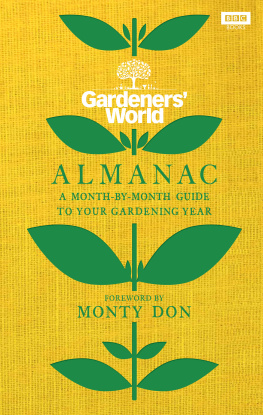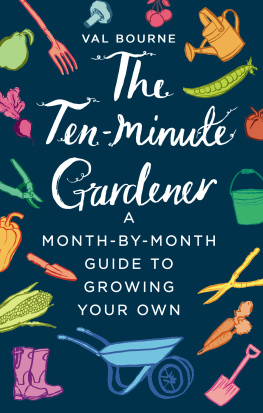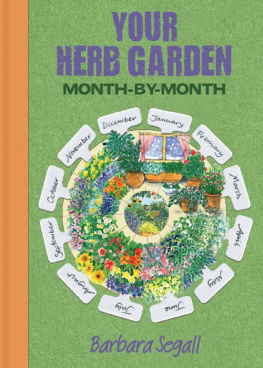AUTHORS ACKNOWLEDGEMENTS
To all my family, who have been very supportive on my allotments and who have allowed me to indulge too many hours there sometimes at the expense of family life.
To Alun Owen and Susanna Wadeson at Transworld/Random House for encouraging me to pass on my allotment knowledge and share my many happy tales of life on the plot!
To all those allotmenteers past and present who provide the rich vein of stories and tips that forms the content of this book.
To Andi Clevely for his tireless support in making this book possible and for driving me on when the going got tough!
About the Book
Green-fingered Terry Walton has been growing his own vegetables and fruit since he was a child. Now, with over fifty years of successful organic gardening behind him, it is little wonder that the advice he offers readers at Saga or listeners of the Jeremy Vine show has brought him an ardent following of allotment and grow-your-own gardeners nationwide.
The Allotment Almanac distils all the hard-earned knowledge, anecdotes and charm that have won Terry so many fans. The result is the perfect companion, combining technical help and reassurance with an ever-wry eye on what Terrys fellow allotmenteers in the Rhondda valley are up to in a month-by-month calendar of life on his now-famous plot, and detailing:
- What to look out for each month
- Plot progress from the first shoots of new life in January to sowing for a new season at the end of the year
- Tasks for the month, both outside and in the greenhouse
- What to prepare for in the month ahead
About the Author
Terry Walton was born in 1946 in the Rhondda, and has lived in South Wales all his life. At the age of four he began to help out on his fathers allotment, taking a plot of his own when he was eleven. He has gardened on the same allotment ever since. Terrys working life was spent for the most part with a local company, where he became managing director. When he retired he was able to focus on his allotment, where he was discovered by Radio 2s Jeremy Vine show team. Terry gives updates live from his hillside plot every fortnight. He is also on the Louise Elliot show on BBC Wales Radio once a month in studio, BBC Radio Hereford & Worcester once a month live from the allotment, and makes appearances on Channel 4 Super Scrimpers to give his gardening tips. Terry has written articles for Saga online and for a variety of publications, including the South Wales Echo and Garden News.
JANUARY
ALONG WITH MANY OTHER GARDENERS , I have little affection for January, usually a thoroughly uninviting month. But shake off the legacy of Christmas excess and home comforts, and (if you look on the bright side) youll notice the days are lengthening already.
There are even signs that herald spring. In my part of the world, for example, daffodils may well start flowering this month. What a strange but uplifting sight these vibrant blooms can be on a misty morn, lighting up a cold, drab day like little beacons of sunshine.
In my youth (many decades ago!) this was a sight associated more often with March. In fact it could be touch and go some years whether there would be a fully open bloom to wear in the traditional Welsh way on St Davids Day. But early flowering of snowdrops and daffodils seems to have grown more commonplace in many areas of the land, another reminder for us of changes to the seasons that are becoming a familiar part of the twenty-first century.
These days I often find myself wondering where winter is hiding. Here in Wales January always used to be very wet and soggy, yet in recent years the month has sometimes been very mild, even positively spring-like when the sun shines. One January, to my surprise, there were definite signs of mating activity in my pond: my frogs had appeared and were doing what usually comes naturally to them in early spring. Clearly its not just us gardeners, but wildlife too thats becoming confused and out of sync with the calendar!
WHAT TO LOOK OUT FOR THIS MONTH
I now find all too often that my overwintered green manure is far more lush than it should be this early in the season. The rye grass, for example, should be no more than 6 inches (15 cm) high for best value, but after one of these mild winters it can be getting close to double that. Doesnt it know its still winter? All the prairie animals of the Rhondda might descend on it soon for their late winter grazing!
One year I discovered the chrysanthemums were already sending up strong early shoots, and, to cap it all, greenfly were taking up residence on these tender shoot tips, much to my annoyance. You cant relax for a minute, even in January when you might think everything is still dormant. It was a case of rummaging for my spray to give them a quick unseasonal wash with warm soapy water and put a stop to the aphids antics before they could do much damage to the new shoots.
Potato plans
Stroll around any garden centre this month and you will see seed potatoes appearing on the shelves. This humble vegetable is worth growing even if you only have a small piece of land or (if really pushed) a few bins or bags.
There is nothing quite like the taste and excitement of harvesting first early potatoes its like digging up buried treasure. They might make plenty of green growth on top, but until I lift them there is no clue to what lies beneath. And as those little white beauties hit the light of day, they give me such a thrill: I can hardly wait to get them home to the kitchen and savour the unique flavour of this first of the seasons crops.
If you are limited for space, early varieties are the best to grow, as they are out of the soil by June, and that ground can then be used for summer salad crops. On my large allotment I like to stagger harvesting throughout the season by planting earlies, second earlies and maincrops. This ensures a steady supply of potatoes on the plate right through the summer, while the maincrop varieties fill bags for use during the winter months.
Patience is a virtue
There are still plenty of winter crops left for me to harvest leeks, cabbages, Brussels sprouts and very soon the first curly kale and sprouting broccoli so we shant go hungry. But as the month progresses the patience of us gardeners is being tested to the full. I keep looking through all my new seed packets, and the urge to start sowing seems to grow daily.
But hold on a little longer, and the time to start will soon be here. When the gooseberry buds, previously tightly closed, show signs of unfurling, thats the cue to begin outdoors. As long as the preparation work is up to date or under way, a week or two longer will not matter to the life cycle of the crops.
Harvesting the leeks
Tales from the plot
Reflect on this great club that we all belong to, the nationwide community of allotment gardeners: a long-established group of like-minded people that must be over three hundred years old all told. This kind of community gardening started in the eighteenth century when landowners, afraid they might lose their workers to better-paid jobs in the towns, decided the best way to keep them on the land was to give them a plot of ground where they could grow their own food. This supplemented their meagre wages while helping to put wholesome food on their families tables.













